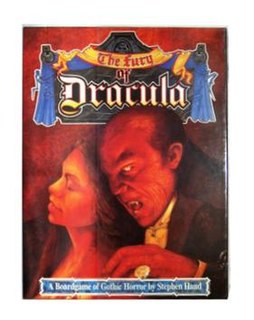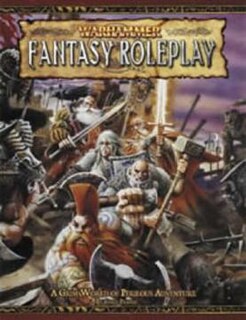
Khonsu is the ancient Egyptian god of the Moon. His name means "traveller", and this may relate to the perceived nightly travel of the Moon across the sky. Along with Thoth he marked the passage of time. Khonsu was instrumental in the creation of new life in all living creatures. At Thebes he formed part of a family triad with Mut as his mother and Amun his father.

Games Workshop Group is a British manufacturer of miniature wargames, based in Nottingham, England. Its best-known products are Warhammer Age of Sigmar and Warhammer 40,000.

Talisman: The Magical Quest Game is a fantasy-themed adventure board game for two to six players, originally designed and produced by Games Workshop. From 2008 to 2017 Fantasy Flight Games produced Talisman under license from Games Workshop. Beginning in 2019 Pegasus Spiele took over production of Talisman and all of the game expansions.

Talisman The Adventure is a 1986 expansion to the Talisman board game, both produced by Games Workshop. The Adventure, which requires the original Second Edition board game, is incompatible with and has no counterpart for the Third Edition, and like Talisman, is currently out of print.

Blood Bowl is a miniatures board game created by Jervis Johnson for the British games company Games Workshop as a parody of American football. The game was first released in 1986 and has been re-released in new editions since. Blood Bowl is set in an alternate version of the Warhammer Fantasy setting, populated by traditional fantasy elements such as human warriors, goblins, dwarves, elves, orcs and trolls.

Mummy: The Resurrection is a role-playing game released by White Wolf Game Studios on March 19, 2001, where the players assume the role of resurrected mummies living in the modern world. Mummy: The Resurrection introduces the Amenti, a new style of mummy instead of those presented in earlier World of Darkness products.

Talisman Timescape is a 1988 expansion for the second edition of the fantasy board game Talisman, both produced by Games Workshop (GW)..

HeroQuest, sometimes written as Hero Quest, is an adventure board game created by Milton Bradley in conjunction with the British company Games Workshop. The game was loosely based around archetypes of fantasy role-playing games: the game itself was actually a game system, allowing the gamemaster to create dungeons of their own design using the provided game board, tiles, furnishings and figures. The game manual describes Morcar/Zargon as a former apprentice of Mentor, and the parchment text is read aloud from Mentor's perspective. Several expansions were released, each adding new tiles, traps, artifacts, and monsters to the core system.

Warhammer is a tabletop miniature wargame with a medieval fantasy theme. The game was created by Bryan Ansell, Richard Halliwell, and Rick Priestley; it was published by the Games Workshop company.
Warhammer Quest is a fantasy dungeon, role-playing adventure board game released by Games Workshop in 1995 as the successor to HeroQuest and Advanced HeroQuest, set in its fictional Warhammer Fantasy world. The game focuses upon a group of warriors who join together to earn their fame and fortune in the darkest depths of the Old World.

Space Crusade is an adventure board game produced by Milton Bradley together with Games Workshop and was first made in 1990. It was produced in the UK and available in some other countries including Finland, Ireland, France, Spain, Denmark, Australia and New Zealand. In Germany, Italy, Belgium and the Netherlands, it is known as Star Quest.

Citadels is a German-style card game, designed by Bruno Faidutti, originally published in French as Citadelles by MultiSim in 2000, illustrated by Julien Delval, Florence Magnin, Jean-Louis Mourier and Cyrille Daujean as graphic designer for the first edition. Sometime later, Citadels was published in German as Ohne Furcht und Adel, which means "Without Fear or Nobility".
Betrayal at House on the Hill is a board game published by Avalon Hill in 2004, designed by Bruce Glassco and developed by Rob Daviau, Bill McQuillan, Mike Selinker, and Teeuwynn Woodruff. Players all begin as allies exploring a haunted house filled with dangers, traps, items, and omens. As players journey to new parts of the mansion, room tiles are chosen at random and placed on the game board; this means that the game is different each session. Eventually the "haunt" begins, with the nature and plot of this session's ghost story revealed; one player usually "betrays" the others and takes the side of the ghosts, monsters, or other enemies, while the remaining players collaborate to defeat them.

Dungeonquest is a fantasy adventure board game originally published in Sweden in 1985 by Alga AB as Drakborgen, and subsequently published in English by Games Workshop in 1987.

The Fury of Dracula is a board game for 2-4 players designed by Stephen Hand and published by Games Workshop in 1987. Fantasy Flight Games released an updated version in 2006 as Fury of Dracula, and a third edition in 2015 by the same name. WizKids Games released a fourth edition in 2019.
Candamir: The First Settlers is a German board game. It is the first game of the Catan Adventure series of games, which share a common theme with the Settlers of Catan games. As such, it was created by Klaus Teuber, and distributed by Kosmos in German and Mayfair Games in English. The name "Candamir" comes from the Settlers of Catan novel by Rebecca Gablé, where Candamir is the name of the main character. The same character is prominently featured in this game.

Warhammer Fantasy Roleplay or Warhammer Fantasy Role-Play is a role-playing game set in the Warhammer Fantasy setting, published by Games Workshop or its licensees.
Atmosfear: Khufu the Mummy is a video board game released in 2006 by A Couple 'A Cowboys and Flying Bark Productions as the last DVD game of the Atmosfear series. The company previously teased a Khufu-themed expansion of Nightmare at the end of Nightmare IV, though declining sales prevented it from occurring.

Kingdom Death: Monster is a cooperative board game created by Adam Poots and released in 2015.
Mummies are commonly featured in horror genres as undead creatures wrapped in bandages. Similar undead include skeletons and zombies.














